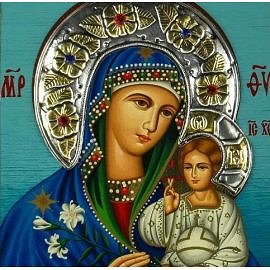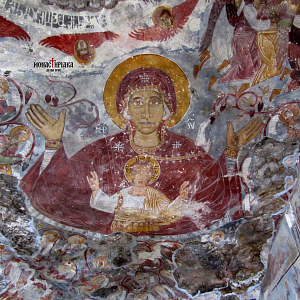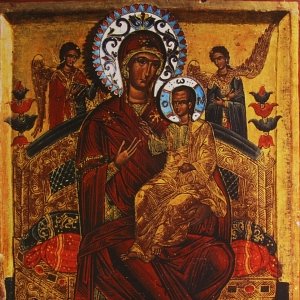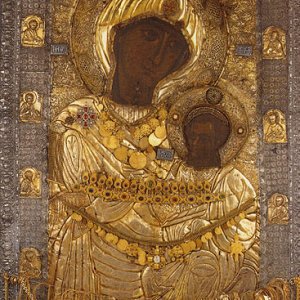Mount Athos is known as the "Garden of Virgin Mary". As the place where the Most Holy Theotokos is honored, as the place where she appears, acts and rests, as "the conceivable and most beautiful Paradise of Theotokos". According to the tradition, Mount Athos was given as a heritage to the Virgin Mary by the Lord himself: "Let this place be a heritage and its surroundings be Paradise, and a port of salvation for those who want to be saved".

Around 1438 AD, the city of Kazan was captured by the Tatars. At that time, the holy icon of Our Lady mysteriously disappeared. After the conquering of Kazan, around 1579 AD, a fire broke out in the Kremlin of Kazan, causing its complete destruction. The Muslims of the city interpreted the catastrophic event as a result of the wrath of the Prophet Muhammad. Hostilities soon erupted among the inhabitants, leading to a civil conflict.

The name of the Virgin Mary, ‘Immaculate’, in Greek ‘Amolyntos’, originates from the hymn of the Compline "Spotless, undefiled, immaculate, unstained, pure Virgin, Lady..." composed by Monk Paul of the Holy Monastery of Evergetis in Constantinople. The Virgin Mary is also called "Our Lady of Passion" as she holds Jesus Christ in her arms and the Archangels, Gabriel and Michael, stand on both sides bearing the symbols of the Passion: the Cross, the Lance and the Sponge.

Around 1702 AD, specifically in early August, preparations for the new harvest began. By order of the local lord, Konte Lianou, all the farmers started to cultivate their vineyards. As the farmers were cutting off the wild weeds with their rakes, known as ‘grava’ on the island, a piece of wood got stuck in one farmer’s rake. In his attempt to take it off, the farmer realized it was an icon of the Virgin Mary! The servant, who was shocked by this event, ran to inform Konte Lianou. Konte Lianou, being very busy with his work and his daughter, who was confined to a wheelchair, ordered the servant to take the icon to the Church of Saint Demetrius.

According to orthodox tradition, the Theotokos, accompanied by the Evangelist John and headed towards Corfu with the purpose of visiting Lazarus, found herself near the peninsula of Athos. Due to a great sea storm, they were forced to disembark at the place where the Holy Monastery of Iviron stands today. It is said that the Virgin Mary admired this place so much that she asked her Son, our Lord Jesus Christ, to grant it to her as a gift. For this reason, Mount Athos is also known as the 'Garden of the Virgin Mary,' and the Theotokos is regarded as the Lady of the Holy Mountain.

The way in which the holy icon of our Lady of Roses was found, was miraculous. According to residents in the area of Piraeus, Greece, the icon was discovered between 1890 AD and 1895 AD. It all began when a fisherman, during his fishing, found the holy icon near the cliffs of Piraeus. Once the news spread in the area, a devout family named Katsaros wanted to provide shelter for the protection of the icon. Thus, on their own initiative, they undertook the construction of a private chapel, which they named Theotokos Rose the Amaranth.

In 1922 AD, the monastery was completely destroyed following the raid and attack by the Young Turks and Kemalists. As a result, the Greeks of Pontus and Asia Minor left their ancestral lands and were permanently uprooted.Before their uprooting, the monks managed to hide the holy icon of the Virgin Mary Soumela in the chapel of Saint Barbara. Along with the icon, they hid a priceless Cross containing holy wood from Manuel III, as well as a handwritten Gospel by Saint Christopher.

The image of \'\'Joy of all\'\' was miraculously found in the village of Klotsky near St Petersburg, Russia, inside a small church. In the early 19th century the temple was destroyed by lightning, while the icon was miraculously saved. Then, in paradoxical way, the coins of the charity\'s broken box were stuck on the icon. Since then the icon has been doing miracles and benefiting the Russian people.

Around 1863 AD, the founders of the Romanian Skete, Fathers Niphon and Nektarios, wanted to place an icon of the Virgin Mary in the Skete, as is customary in all monasteries on Mount Athos. So, they went to Iași in Romania and found a devout iconographer, Iordache Nicolau. They asked him to create an icon of the Theotokos followed by prayer and fasting. He accepted the request and began the process with great respect and dedication. At the beginning of the iconography, Iordache tried to paint the garments of the Theotokos and Jesus Christ. Once he completed them, he continued with the holy faces but he was unable to achieve a satisfactory result.

The holy and miracle-working icon of the Virgin Mary was brought to the Vatopedi monastery by the blessed elder Joseph from Nea Skete. The first record of the icon\'s miraculous powers is from the witness of Elder Joseph. One day a young man from Cyprus went to visit and entered into the church. At that point, the elder witnessed a glowing light radiating from the face of the Theotokos and an invisible power pushed the young man down to the ground. When the young man had recovered from his fall, he began to repent and weep and confessed that he did not believe and was a participant in the black arts. He changed his life and became an Orthodox Christian.
The renowned icon of the Theotokos Axion Estin follows the strict standards of Byzantine art and is adorned with a silver-gold cover and Byzantine decoration. It depicts the Virgin Mary holding the child Jesus Christ with her right hand. Jesus Christ holds a manuscript scroll in his right hand with the inscription «The Spirit of the Lord is upon Me... » while his left hand is beneath the veil (maphorion) of the Ever-Virgin Mary.

According to Orthodox tradition, the icon of the Theotokos Portaitissa was kept in Nicaea, Asia Minor. It was placed in a private church by a devout woman and her son. During the second iconoclasm, spies of the king discovered the presence of the icon and threatened the woman’s life unless she bribed them. The God-fearing woman promised to give them money, thus gaining one more day.

The holy icon of the Most Holy Theotokos is associated with many miracles. One of the first miracles occurred in the 10th century when Arab pirates attacked the monastery. At that time, Hierodeacon Savvas, who was responsible for the monastery's holy relics and treasures, immediately rushed to protect the icon of the Theotokos and threw it into the water well of the Sanctuary. Along with the icon, he placed the cross of Saint Constantine the Great and a lit candle that burned in front of the holy icon in the same spot. However, he could not escape himself from the pirates, who captured him and sold him in Crete island. Approximately seventy years later, Crete was liberated from the pirates during the reign of Emperor Nikephoros Phokas. At the same time, Saint Savvas was also set free and, though very old by then, managed to return to the monastery.